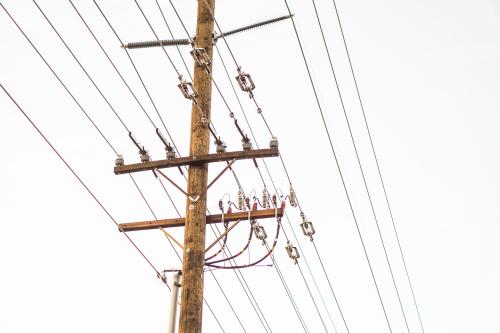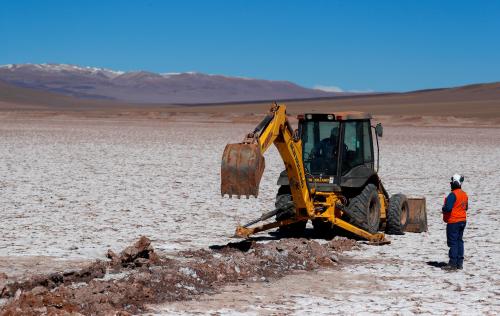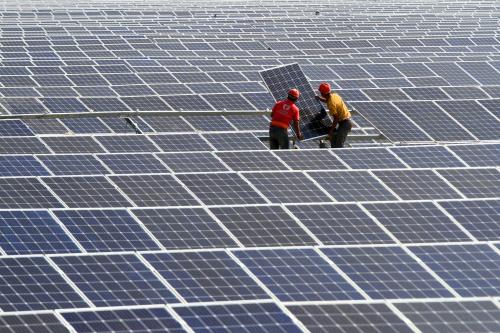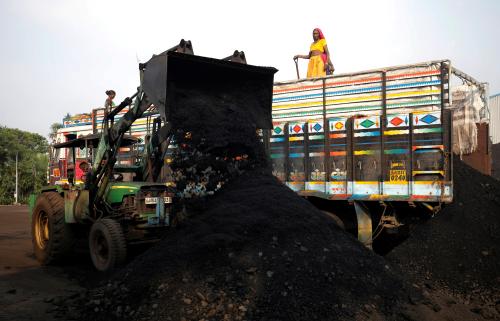Content from the Brookings Institution India Center is now archived. After seven years of an impactful partnership, as of September 11, 2020, Brookings India is now the Centre for Social and Economic Progress, an independent public policy institution based in India.
A version of this article was first published on the World Economic Forum website on May 19, 2020 and can be accessed here.
India, like other countries, had an ongoing energy transition, but the question becomes will COVID-19 create a pause or a shift in the trajectories? Or, will it induce radical change? No one can know for sure, in part because we don’t know what the “new normal” will be, but also because timeframes are critical to this puzzle. In the short run, India imposed the world’s most stringent lockdown against COVID-19. There is a long period of recovery expected, with not just a recession but also shifts in spending patterns, with hits to tourism (~10% of GDP), luxury items, and even discretionary purchases.
The underlying issues
A crisis doesn’t just create new challenges, it sharpens existing challenges. If it pushes a system off the precipice, the factors that got us to the edge are key to understanding what might happen in the future. India’s 2019 WEF Transition Index Ranking was middle-of-the-pack, but this score masked some important details. First, coal, which is half of India’s energy, is being replaced by renewable energy (at least for most new electricity), and in the longer run, there was a move towards electrifying mobility (EVs). India’s Renewable Energy (RE) ambitions are actually amongst the most aggressive in the world, but the short-term target of 175 GW Renewable Energy (RE) by 2022 announced in 2014-15 appeared “easy” both in the sense that it wouldn’t require major grid upgrades or storage and it’s aligned with the new business-as-usual based on cheap RE prices, especially for solar power.
While the AC electrical grid always has to be in real-time balance between demand and supply, India’s financial balance was always precarious, with loss-making distribution utilities at the end of the chain. Social welfare redistribution has long been a key aspect of energy policy, where commercial and industrial users overpaid to cross-subsidise homes and agriculture. This entire model is at risk after COVID-19, forget during the lockdown, where overall demand is down 25%. For example, TCS, India’s largest IT company, plans to have 75% of their people working-from-home by 2025.
What COVID-19 changes
The immediate challenge is one of financial liquidity. Analysts expect the annual losses of the distribution companies (Discoms) to double to about $15 billion. Cash will be scarce, and new investments will face more hurdles. The only recent generation investments were in RE, and these may also be at risk, more so as they were about capital over labour. Out of the labour component, much of it was elsewhere based on manufacturing. Imports dominate solar modules, with 88% of imports coming from China.
India already was grappling with surplus generation capacity and stressed assets. Decisions for adding new firm (non-RE) capacity were already a few years away, and these decisions are likely pushed out even further thanks to COVID-19. The earlier equilibrium had about 90% of power coming from static power purchase agreements (PPAs), but demand is way down. While the power exchanges (a small fraction of total supply) now have very low prices, PPAs have limited the value of cheap third party supply, unless DisComs claim force majeure, the new buzzword. On the other hand electricity remains a notified essential service, and cannot be switched off. The need for Discom cash flows may also give impetus to innovative technologies, especially accelerated smart metering. It’s ironic that labour (in a land of 1.3 billion people) is again viewed as a bottleneck.
While reforms, the dual of a transition, were also underway, COVID-19 may create counter forces as well. First, economics and financial engineering were overcoming older lenses of energy security (most explicit in oil and gas), but the pandemic has made all countries worry about supply chains, strategic capabilities, etc.
Imports from China are just one concern, but there is also a renewed push for Make in India, a central government programme to boost manufacturing but one that is implicitly about jobs. An employment lens suggests more coal (which is mostly domestic, especially thermal coal, as opposed to metallurgical coal). India may finally focus stimulus money on strategic investments not just for RE but for batteries, key to both EVs and high penetrations of RE.
Being more speculative, it’s possible that we’ll lose some competition and even innovation. As Winston Churchill said, “Now this is not the end. It is not even the beginning of the end. But it is, perhaps, the end of the beginning.” In the post-Covid era, it’s likely that the big (and public sector) will survive, or even thrive, with access to funds, scale, and even technology. The small and niche may also thrive, but India’s informal economy, the majority of employment, hasn’t been globally competitive. In the new world, it may not need to be.
Ensuring a just transition
Clean skies from the lockdown may make people want “clean” as part of the transition, but obviously not at such a high human cost. This exemplifies the real challenge of the transition – handling winners and losers. India can’t pay off the losers, and so it will require deeper change.
Proposed amendments to the Electricity Act 2003 give a glimpse of bold reforms needed to change the status quo. If subsidies are now to be given to end-consumers directly, they should pay “full cost” for their electricity, which is a sea-change. Overall, India should make social welfare objectives more direct and explicit, perhaps as a line item in consumer bills. This would make it easier to use separate funds (including stimulus money) for these. Else, policies ostensibly in the name of the poor simply have led to systemic inefficiency and poor targeting.
Say we have no more greenfield coal power plants built. This still means by 2030 about half the electricity comes from coal. So we have to clean up coal, not wish it away. India will have to find the funding and the instruments to pay for things like cleaning up emissions from coal power plants. Maybe India could consider adding new ultra-super-critical coal plants when required to shutter older and dirtier plants even before they reach their end-of-life.
It’s too early to predict if we’ll have deep structural change – but even if we don’t, the next one or two years will not be a continuation of the past. Planning under extreme uncertainty may be the real need, across jurisdictions, domains, and ministries, not to mention across public and private. This is made more complex due to the long lifespans of many investments, not just in generation capacity but the broader ecosystem of transportation, natural resources, and consumption.
India was already undergoing change. Some of the needed reforms, on pricing, regulation, risk allocation, and market design, were pending or pushed back in the past, mostly because they were politically unpopular. Maybe this is the time for taking even tougher decisions than in the past.







Commentary
Op-edHow COVID-19 might impact India’s renewable energy transition
May 20, 2020